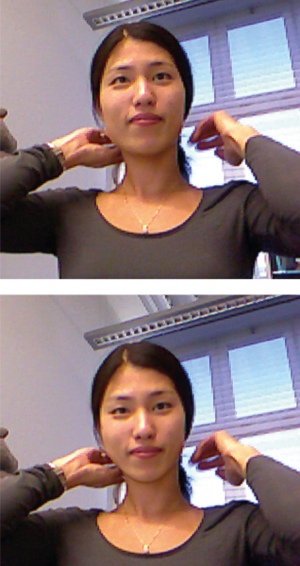
The bottom image shows how the research team's
software works to alter Skype transmissions.
Credit: Computer Graphics Laboratory ETH Zurich
Looking someone in the eye is one of the most basic social cues us humans have. It helps connect us to other people, show sympathy and indicate that you’re actually listening to what someone has to say. Unfortunately, it's not something you can do over the Internet. And I’m not just talking about the impersonality of email here; I’m talking about Skype video chat. If you look at someone’s eyes on Skype, you’re not looking at the camera. If you’re not looking at the camera, then it doesn’t appear to the other person that you’re looking them in the eye. It’s a Catch-22.
Apparently this little pet peeve of mine is the subject of some pretty intense academic research. A group of students and scientists at the Computer Graphics Laboratory ETH Zurich have created a relatively inexpensive way to maintain eye contact during Skype chats. There are two main components to the system: A software program and a Microsoft Kinect movement sensor.
As you talk via Skype, the Kinect will keep tabs on your face (and anyone else in the camera’s view), specifically tracking 66 different points as they move around in real time. The software then goes to work, altering the transmitted image to make it look like you're staring at the camera when you're really looking at the screen instead. One would naturally expect these Frankenstein images to look unnatural, awkward and jarring. But as you can see in the photo above, they actually look pretty good. It'll make the kids look more engaged with grandma on those long-distance chats, and it could prove a competitive advantage for anyone who makes sales calls using video chat.
Not everyone has a Kinect, of course, so the research team is trying to see if they can come up with a way to make their software work with the cameras you already have on your devices. They're also working toward creating Skype plug-in so we can all enjoy the results of their academic research. This is definitely an innovation worth keeping an eye on (pun fully intended).
















